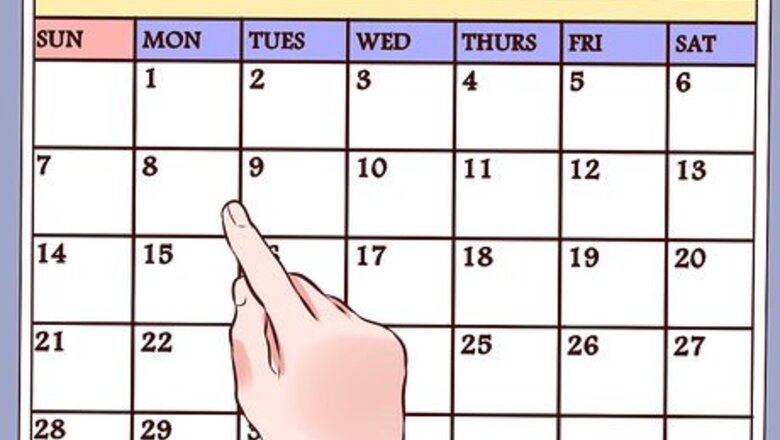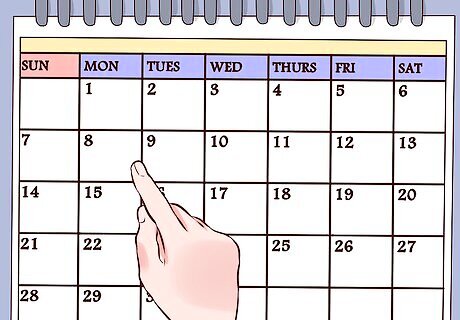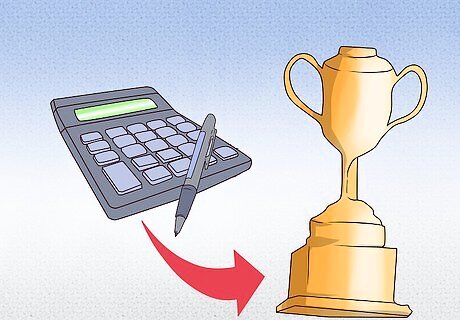
views
Organizing the Challenge

Set the dates for the competition. Anywhere between 6 and 8 weeks is the shortest duration you should attempt for a weight loss challenge. Shorter challenges will have the least drastic results in the end, but they can also be the most productive because there’s a slight sense of urgency throughout the competition. Between 8 and 10 weeks is the most commonly used time frame for a weight loss challenge. Give the challenge a catchy name that references the duration of the event, like the “10-Week Lifestyle Reboot” or something else similarly motivating. 12 weeks should be the maximum duration for a weight loss challenge. After 12 weeks people may start to lose interest in the competition or drop out because it’s too strenuous.

Set realistic rules. The recommended and safest rate of weight loss is approximately 1 to 2 pounds (0.5 to 1 kilogram) per week. On average, you need to burn 500 to 1,000 calories more than you consume each day, by way of diet and exercise, to lose 1 to 2 pounds a week. This is a realistic goal that everyone can shoot for. As host of the competition, it will be your responsibility to convey to the participants that ultimately the contest is about health, not weight. Caution your participants about using extreme measures and unhealthy methods to lose weight, and warn them about the dangers of losing too much weight too quickly. When you host the first meeting, provide literature about healthy weight loss strategies, along with quality information about diet and exercise for safe weight loss. Emphasize that they should use diet and exercise to lose weight, not starve themselves. State clearly and kindly that you'll have to privately intervene if you notice anyone who starts shedding weight inexplicably fast or starts to look unhealthy during the contest and that it could result in their disqualification.

Determine how to measure success. Most challenges measure success by pounds lost, and this method will be easiest for you to measure. Providing the data in pounds lost will also more straightforward for the participants. Ultimately, the winner will be determined by calculating the highest percentage of weight loss over the time period of the challenge. Record each participant’s weight every week, and on the final day of the competition you will get the average of those weekly weigh-ins and subtract that number from the participant’s start weight. The objective is to reveal who showed the most improvement over the course of the contest, measured by percentage of weight loss. Sometimes weight loss challenges will measure success by body fat percentage instead of pounds lost. Both methods of measurement are effective, but it may be easier to measure body fat percentages accurately if you have a personal trainer or fitness expert involved in the competition.

Decide if participants will work as teams or individually. Working in teams can be a lot more fun (and effective) for everyone involved. If you decide to do teams, the process will be slightly different. Create small groups of 2 to 6 people, with one of them acting as team captain. Success will be measured by total percentage lost by the group rather than individually. The weigh-ins will work the same as with individual play, except that the team captain will record everyone's weights and submit them each week. The captain will also be responsible for making sure everyone in the group makes the weigh-ins and for team support in general.

Set the entry fee (if you're going to have one). Make it something affordable, like $25 or $50 per person. The collected amount can fund the cash prize for the winner and also cover any expenses associated with the competition, such as T-shirts or planning a post-challenge party to celebrate everyone’s success. If you decide to require an entry fee, task one person with being in charge of the funds throughout the challenge. Keep the money in a secure place, like in a lock box or safe, and make sure that all expenses are well-documented. Skip the entree fee requirement if you think it will discourage others from participating in the challenge. If you aren’t sure, send out an email to announce the competition. Get a feel for who is interested in competing and then poll those people about what amount would be fair and affordable to charge as an entry fee.

Determine what the winner will receive. Usually the reward is the cash prize generated from the collected entry fees (minus any expenses). You could also offer prizes like laptops, iPads, or gift certificates, if you have that capability. If you are holding the challenge for colleagues at your place of employment, ask your employer to sponsor the event and provide prizes for the competition. You’ll need to decide if the winner takes all, or if you plan to have first and second place winners in the competition. A winner-takes-all prize is certainly more of an incentive for the participants, but if you have several generous prizes planned, it would make sense to have first and second place winners.

Obtain authorization before you announce it if you plan to hold the weight loss challenge at work. Supply someone in management with all of the challenge information and guidelines. Additionally, you should speak with someone in the Human Resources department about the contest. When announced, it should be stressed that participation is completely optional. Enlist the HR department's help in announcing the contest, as well as monitoring employees for any unsafe or negative behavior. Consider having the HR department speak to everyone as a group about safety. Since crash diets can affect work performance, HR will need to help monitor the staff for any behavioral or performance changes. If anyone on staff is uncomfortable with the contest because of past (or current) eating disorders, or for any other reason, let the group know when the contest is announced that the employee should speak to the HR department privately about it. If there are any major protests or problems reported, have HR help you shut down the competition. Wait for the official go-ahead from management and Human Resources before announcing anything about the competition to your colleagues. Since the challenge will encourage employees to be healthier, find out if your employer would be willing to help cover expenses and provide the cash prize.
Promoting the Challenge

Get others involved. Whether you're setting up the competition for your friends, family, or colleagues, a successful challenge requires active and engaged participants. Establish who you want to recruit and announce the competition via email. Create fliers, emails, a Facebook group and, if possible, provide a website where people can get more information and sign up to participate.

Emphasize health. Consider calling it a Wellness Competition rather than a Weight Loss Competition, to put the emphasis on health rather than weight loss. Promote the competition with vocabulary and imagery that is health-oriented and not completely weight-focused.

Motivate with additional incentives. Along with announcing the competition prizes, try upping the stakes. Have each participating person or team choose their favorite charity or community outreach program and offer to award a portion (or even all) of the prize money to the chosen beneficiary. If you are organizing the challenge among coworkers, ask if your company will match the donation.

Attract participants with supplementary educational opportunities. Recruit local health and wellness professionals to provide informal seminars throughout the challenge on subjects related to fitness, well-being and weight loss. Invite a local chef to demonstrate healthy cooking and provide recipes. Visit personal trainers and gyms in your area to see if they would like to offer their services or become involved in the challenge in some way.
Hosting the Introductory Meeting

Establish clear contest guidelines. Create well-defined policies for all components of the challenge and provide this information to the participants in document form. Additionally, post the contest rules on the challenge website and make them available through social media. Detail the prizes and any other important information that relates specifically to the contest. Make sure to include all important dates, the rules for entry, and the procedure for how measurements will be taken. Don’t forget to include any prohibited activities that could result in disqualification, such as taking weight loss supplements or engaging in unsafe weight-loss strategies. If you are organizing the competition at work, ask management to sign off on the policies and procedures. Make sure that the Human Resources department reviews all of the information, and enlist their help for monitoring the staff for any red flags.

Outline the weigh-in and measurement procedures. Arrange a space for this purpose and have the entire process organized prior to announcing the contest. Taking measurements can be done as simply as using a bathroom scale to record the participants’ weight, or you could plan to have a personal trainer or health professional weigh-in participants and take body fat measurements. The most accurate way to track weight loss is by setting a routine day and time (preferably in the morning before breakfast) each week to record the measurements. Network with local community experts, such as personal trainers and nutritionists, and offer them the opportunity to make new contacts or give talks in exchange for taking measurements.

Provide a firm start date for the competition. Set this date in stone and establish a deadline for entries, so that the challenge follows a strict and manageable timeline. Announce the meeting time and place for the initial weigh-in and answer any questions about the process. Reassure the participants that all weight information will be kept confidential.

Encourage all participants to schedule a physical with their doctors prior to starting the challenge. Consulting a physician before embarking on a new health routine is a good habit for everyone to get into and setting that standard lends a professional quality to your challenge. It also emphasizes that good health is more important than any weight that might be lost in a competition. If you want total peace of mind about the health of your participants, you could even make this a requirement upon entry.
Conducting the Challenge

Host the initial weigh-in to kick off the competition. Have the participants come in to be weighed and record everyone’s starting weight using whatever method you established at the introductory meeting. Use a systematized method, such as a spreadsheet, to record the name and starting weight of each participant. Make sure that everyone knows the dates and times for the weekly weigh-ins for the remaining duration of the challenge. If desired, you could photograph each participant at the initial weigh-in and plan to do the same at the final weigh-in. You could then provide your participants with a before and after snapshot to document their success.

Send out regular group emails during the competition. Each week, after everyone has weighed in, send out an encouraging email to all the participants. You can keep the participants updated on who’s in the lead throughout the competition, or simply offer motivation and encouraging words to keep everyone engaged in the challenge. Additionally, try sending out group emails throughout the duration of the challenge that provide a steady stream of healthy weight-loss tips, recipes, resources and encouragement to your group.

Organize small events during the competition. Create opportunities for the participants to get together periodically during the challenge. This gives everyone a chance to meet face-to-face to support one another and share their weight-loss experiences while also fostering a sense of community among the competitors. You can also use these mini-events as opportunities to gauge and maintain everyone’s interest and enthusiasm in the challenge. Mid-challenge events could be almost anything that you think would pique the interest of your participants. Offering a complimentary yoga class, hosting a fun run, and inviting everyone to a healthy pot-luck picnic at your local park are all great examples of motivational events.

Create a private Facebook group for the participants. Encourage them to share their personal diet and exercise tips there, as well as their experiences and progress photos. Promote a sense of community rather than focusing solely on the competitive element of the challenge. If possible, provide a way for the participants to receive feedback and support and frequently share resources like weight loss websites and health forums with the group.
Revealing the Winner

Host the final meeting and weigh-in. On the day the competition ends, have everyone come in for their final weigh-in. Hold the meeting first thing in the morning, prior to breakfast, since that’s the best time to gauge everyone’s most accurate weight. Meticulously record everyone’s final weight and plug the numbers into your spreadsheet. Offer a simple, healthy assortment of breakfast foods for your participants to enjoy after their final weigh-in. Let everyone know how and when you will be revealing the results of the challenge. You could host an announcement party at lunchtime that day or soon after, so that the participants don’t have to wait too long to hear the news.

Calculate the final percentages to get your winner. For each participant, calculate the average of their weekly weigh-ins. Subtract that number from each participant’s starting weight, and this will give you a very precise measure of how much progress each person made.

Announce the winner and award the prize. Gather everyone together and reveal the winner. Provide each participant with individual progress reports that show the data you collected during the competition to highlight their individual successes. Calculate the total overall weight lost by the group and announce that number, as well, congratulating the group on their collective success. Thank everyone for their participation and encourage them to continue the healthy habits they’ve established during the challenge. Send out a group email that details all of this information, so that anyone who couldn’t attend the announcement will know who won. You could send out the progress reports individually via email, as well.

Celebrate! After the winner is announced, make sure everyone sticks around for a mini-celebration. Cater the event with healthy food options and provide weight-loss literature and resources that the participants can take away with them. Keep the atmosphere positive and emphasize that everyone was successful, even if only one winner was chosen.




















Comments
0 comment